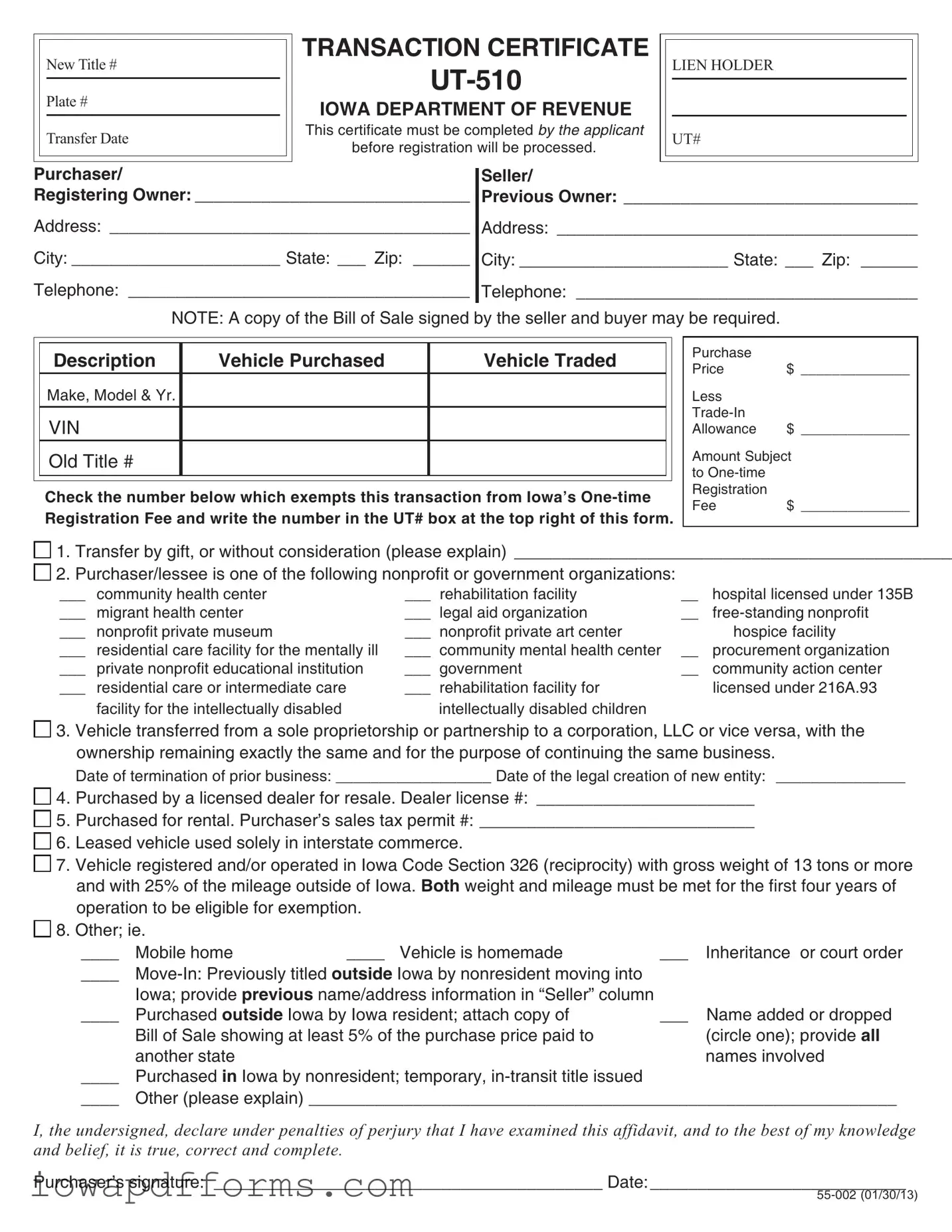The UT 510 Iowa form is primarily concerned with the transfer of vehicle ownership in Iowa. It serves as a transaction certificate that must be filled out by the applicant before the registration process can begin. A document that shares similarities with the UT 510 is the Vehicle Title Application. Like the UT 510, the Vehicle Title Application is used to register a vehicle and requires information about the buyer, seller, and vehicle details. Both documents aim to ensure that the transfer of ownership is documented properly and that all necessary information is collected for the registration process.
Another document that resembles the UT 510 is the Bill of Sale. This document serves as proof of the sale of a vehicle, detailing the transaction between the buyer and seller. Similar to the UT 510, the Bill of Sale includes critical information such as the vehicle's make, model, and VIN, as well as the purchase price. While the UT 510 is specifically for registration purposes, the Bill of Sale functions as a legal record of the transaction itself, reinforcing the legitimacy of the ownership transfer.
The Application for Duplicate Title is another document that parallels the UT 510. This form is used when a vehicle owner needs to replace a lost or damaged title. Both documents require similar information about the vehicle and its ownership. The Application for Duplicate Title ensures that the ownership record remains intact, just as the UT 510 facilitates the smooth transfer of ownership from one party to another.
The Affidavit of Inheritance is also comparable to the UT 510. This document is used when a vehicle is transferred to an heir after the original owner's death. Like the UT 510, it requires details about the vehicle and the new owner. The Affidavit of Inheritance ensures that the transfer of ownership is legally recognized, similar to how the UT 510 formalizes the transfer process for buyers and sellers.
When engaging in the process of buying or selling a trailer, it is essential to have a legal framework that records the details of the transaction clearly. In this context, utilizing a Trailer Bill of Sale form is vital, as it not only outlines the terms and conditions of the sale but also serves to formalize the transfer of ownership. For more information on how to create this document, you can explore the following resource: https://billofsaleforvehicles.com/editable-trailer-bill-of-sale/.
The Vehicle Registration Renewal form shares similarities with the UT 510 as well. While the UT 510 is focused on the transfer of ownership, the Vehicle Registration Renewal form is used to maintain the registration of a vehicle under its current owner. Both forms require information about the vehicle and its owner, ensuring that the state has up-to-date records regarding vehicle ownership and registration status.
The Lien Release form is another document that has a connection to the UT 510. This form is used to formally release a lien on a vehicle, indicating that the debt associated with the vehicle has been satisfied. While the UT 510 focuses on the transfer of ownership, both documents play a crucial role in maintaining accurate records of vehicle ownership and financial obligations related to the vehicle.
Lastly, the Application for Title and Registration for a Motor Vehicle is similar to the UT 510 in that it is used for the initial registration of a vehicle. This form collects information about the vehicle, its owner, and any liens on the vehicle, much like the UT 510 does during the transfer process. Both documents aim to ensure that the vehicle is properly registered and that ownership is clearly established in the eyes of the law.

